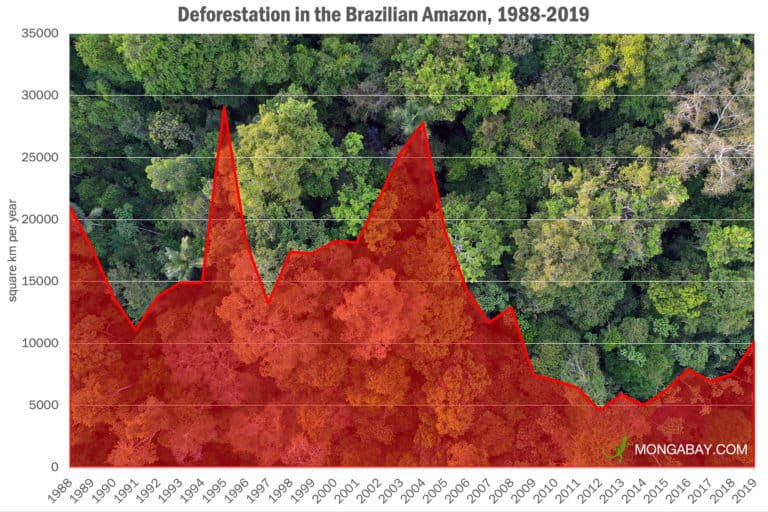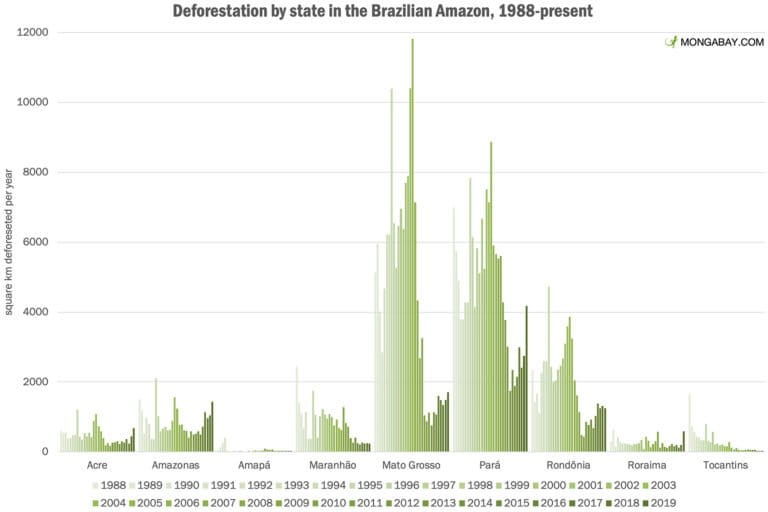- Deforestation in the Brazilian Amazon surpassed 10,000 square kilometers in 2019, the first time forest clearing in Earth’s largest rainforest has topped that mark since 2008, according to revised data from Brazil’s national space research institute INPE.
- INPE says that 10,129 square kilometers of forest were cleared across the “Legal Amazon” between August 1, 2018 and July 31, 2019. That’s 3.8% higher than the preliminary estimate the government provided in November.
- Forest loss in 2020 is pacing well ahead of last year’s rate according to INPE’s short-term deforestation alert system.
Deforestation in the Brazilian Amazon surpassed 10,000 square kilometers in 2019, the according to revised data from Brazil’s national space research institute INPE. It’s the first time forest clearing in Earth’s largest rainforest has topped that mark since 2008.
INPE says that 10,129 square kilometers of forest were cleared across the “Legal Amazon” — an area that includes parts of eight Brazilian states — between August 1, 2018 and July 31, 2019, the “year” Brazil uses for tracking deforestation. That loss is 3.8% higher than the preliminary estimate the government provided in November, but it is line with the revision the normally occurs several months after the initial estimate is published.

The new figure indicates that deforestation in the Brazilian Amazon was 34.4% higher in 2019 than the prior year. Deforestation has now increased in five of the past seven years since bottoming out at a historic low of 4,571 sq km in 2012.
Forest loss in 2020 is pacing well ahead of last year’s rate according to INPE’s short-term deforestation alert system called DETER. Through mid-May 2020 over 6,000 sq km of forest had been cleared since August 1, 85% more than the same time last year and the fastest rate of loss since at least 2007.

Observers have blamed the Bolsonaro administration for the sharp increase in Amazon deforestation since last year. They cite the president’s heated rhetoric against environmental groups and indigenous peoples, efforts to roll back environmental regulations and strip protected areas of their status, and decision to reduce environmental law enforcement and penalties for illegal forest clearing. Bolsonaro has openly called for increased logging, mining, dam-building, and agricultural expansion across the Amazon.

Deforestation in 2019 increased most rapidly in the northern state of Roraima, which is experiencing a mining boom. Most deforestation however occurred in Pará, Mato Grosso, Amazonas and Rondônia.
Brazil is about to enter into the dry season, which is typically when the bulk of deforestation and fire occurs in the Amazon. Last year fires in the Amazon made global headlines when the resulting smoke blackened the skies above São Paulo, one of the world’s most populous cities.
Scientists fear that continued deforestation, combined with the effects of climate change, could trigger the Amazon rainforest to “tip” toward a drier, savanna-like ecosystem. Such a shift would have profound implications for the region’s biodiversity, rainfall patterns, and forest-dependent peoples.

